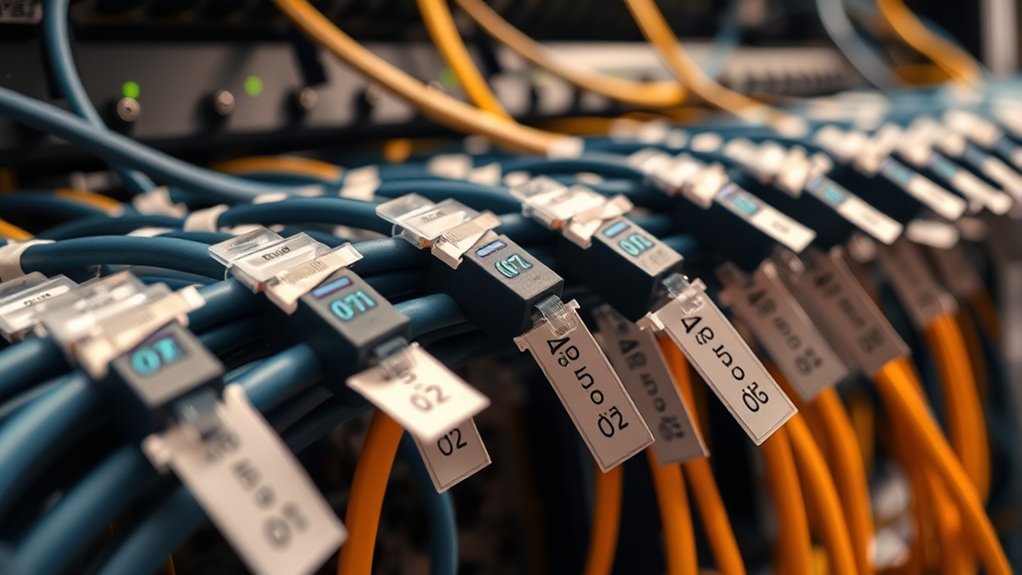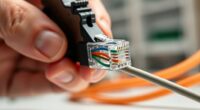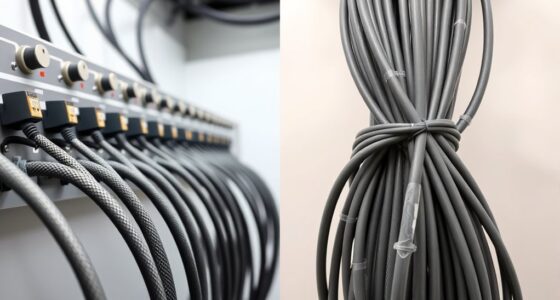To improve cable labeling and documentation, start by establishing a consistent system with clear naming conventions, color coding, and logical numbering. Use durable labels resistant to environmental factors and make certain they are placed visibly at key points. Keep accurate records of cable runs, terminations, and maintenance activities, preferably using digital tools for easy updates. Following these steps helps prevent confusion and simplifies troubleshooting—and the more details you incorporate, the easier it becomes to manage your system effectively.
Key Takeaways
- Develop a standardized labeling system with consistent prefixes, color codes, and numbering for easy identification and troubleshooting.
- Use durable, high-quality labels resistant to environmental factors like moisture, UV, and chemicals to ensure longevity.
- Document cable paths, terminations, and modifications accurately using diagrams and digital record-keeping tools.
- Apply clear, visible labels at cable ends and along runs, ensuring readability without obstructing airflow or access.
- Regularly update labels and documentation to reflect system changes, maintaining accuracy for maintenance and troubleshooting.
Planning Your Labeling System

Before creating your cable labeling system, you need to plan carefully to guarantee it’s effective and easy to maintain. Start by selecting a consistent color scheme for different cable types or functions; this visual cue simplifies identification and troubleshooting. Consider how you’ll place labels—ensure they’re clearly visible without obstructing connections or airflow. Proper label placement involves sticking labels at both ends of a cable or at key connection points, making it easier to trace cables quickly. Think about how the colors and placement will work together to create a logical, intuitive system. Keep in mind that a well-planned approach reduces errors and saves time during future maintenance or upgrades. Additionally, understanding cable organization strategies can help you design a more efficient and durable labeling system. Incorporating clear labeling standards ensures consistency and makes future updates straightforward. To maximize efficiency, integrating quality labeling materials can improve durability and readability over time. Considering long-term maintenance concerns from the outset ensures your system remains clear and functional over time. Ultimately, your goal is a clear, organized labeling system that’s straightforward to understand and update.
Choosing the Right Labeling Materials
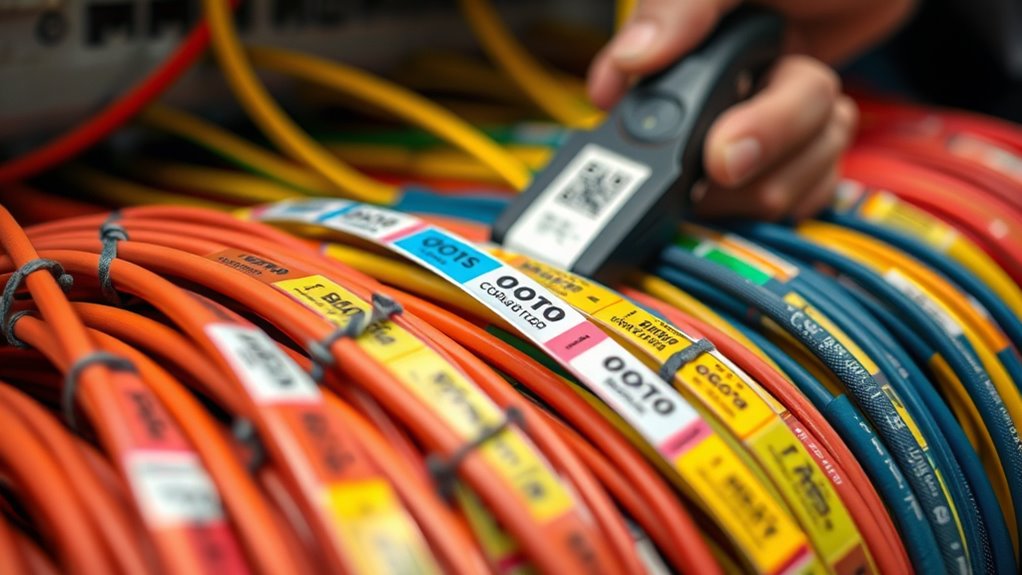
When selecting labeling materials, you need to consider how durable they’ll be over time and under different conditions. Make sure the labels are compatible with your cables’ surfaces and environments to prevent peeling or damage. Choosing the right materials now saves you time and effort in the long run. Additionally, considering data privacy challenges ensures that your labeling practices do not compromise sensitive information or violate regulations. Incorporating industry standards can further ensure your labeling remains compliant and reliable over time. Understanding personality traits can also help tailor your labeling approach to team preferences and workflows. Being aware of material compatibility can help prevent issues like smudging or fading, especially in demanding environments.
Label Durability Factors
Choosing the right labeling materials is essential to guarantee your cable labels stay legible and intact over time. Durability depends on several factors:
- Environmental resistance: Select labels that withstand exposure to moisture, UV rays, and temperature fluctuations. For outdoor or industrial environments, UV resistance is particularly important to prevent fading or degradation. Additionally, understanding the sustainable practices involved in material selection can help reduce environmental impact and promote eco-friendly labeling solutions.
- Adhesive strength: Ensure the adhesive can secure the label firmly without peeling, even in demanding conditions.
- Material flexibility: Use flexible materials for cables that bend or move frequently, preventing cracking or peeling.
- Chemical resistance: Opt for labels resistant to oils, solvents, and other chemicals that could degrade lettering or material.
- Proper labeling practices also play a crucial role in maintaining label integrity over time, especially in Gold IRA Rollovers environments. Proper application techniques and using high-quality labels will help ensure longevity and readability.
Material Compatibility
Selecting the appropriate labeling materials is essential to guarantee your labels remain clear and durable over time. You need to consider insulation compatibility to ensure the labels won’t degrade or peel when exposed to heat, moisture, or chemicals. Choosing materials that match your cable’s insulation type prevents damage and maintains readability. Additionally, pay attention to adhesive strength; strong adhesives ensure labels stay attached even in harsh environments, while overly aggressive adhesives can damage surfaces or be difficult to remove later. Proper material compatibility reduces the risk of label failure, which can lead to confusion or errors in your documentation. Considering environmental conditions specific to Honda Tuning components’ application can help you select the most suitable labels for automotive applications. By selecting labels that suit your cable’s environment and surface properties, you enhance long-term visibility and reliability of your labeling system. In environments with extreme temperatures or chemical exposure, selecting high-performance labels can further ensure durability and clarity over time. Ensuring material compatibility with your cables helps prevent premature label deterioration and simplifies maintenance.
Establishing Standardized Naming Conventions

Establishing standardized naming conventions is essential for guaranteeing consistency and clarity across your cable management system. To do this effectively, you should develop a system based on unique naming conventions and standardized abbreviations. Consider these steps:
Standardized naming conventions ensure clarity and consistency in your cable management system.
- Define clear, concise prefixes for different cable types or locations.
- Use standardized abbreviations for common terms to maintain uniformity.
- Incorporate sequential or logical numbering to identify cable runs or ports.
- Document your conventions and ensure everyone follows the same rules.
- Pay attention to color accuracy to ensure your labeling is visible and easy to read under various lighting conditions.
- Additionally, understanding asset division laws and practices can help in organizing and managing equipment and documentation effectively, especially in complex setups, and incorporating clear communication strategies can further enhance consistency and understanding among team members. Recognizing cable identification standards can also streamline troubleshooting and future upgrades.
Documenting Cable Paths and Terminations

You need to keep an accurate map of cable paths to prevent confusion during maintenance or troubleshooting. Clear termination records guarantee you can quickly identify connections and reduce errors. Proper documentation makes your entire system more reliable and easier to manage. Incorporating comprehensive AI insights can also help automate and verify your documentation processes, ensuring accuracy and efficiency.
Accurate Path Mapping
Have you ever wondered how accurate cable path documentation can prevent troubleshooting headaches? Proper path mapping ensures you can quickly identify cable routing and the location of all terminations. To achieve this:
- Trace each cable from source to destination, noting the exact route.
- Record cable routing details on clear diagrams, including bends and junction points.
- Place labels at strategic points, such as cable ends and along runs, for easy identification.
- Keep labels visible and consistent, ensuring label placement aligns with documented paths.
- Incorporate thorough cable documentation practices to maintain an up-to-date record of all cable configurations and ensure network reliability.
- Utilizing Pimple Patch techniques, such as detailed labeling and documentation, can further enhance your cable management practices.
Accurate path mapping minimizes confusion during maintenance or troubleshooting. It helps you quickly pinpoint issues, avoid unnecessary disconnections, and streamline cable management. Precision in documenting cable routing and label placement is key to reliable and efficient network operation.
Clear Termination Records
Accurate cable path documentation is only complete when termination records clearly detail each connection point. You should record every termination, noting the cable’s color codes to guarantee easy identification. Using consistent color codes simplifies troubleshooting and future modifications. Labeling software options can help you create precise, easy-to-read records that include cable IDs, port numbers, and connection points. Make sure each record matches the physical setup, reducing confusion during maintenance or upgrades. Clear termination records also aid in verifying cable continuity and integrity. Keep your documentation up to date, and review it regularly to reflect any changes. Properly documented termination details save time, prevent errors, and ensure your cabling system remains organized and reliable.
Utilizing Color Coding for Easy Identification
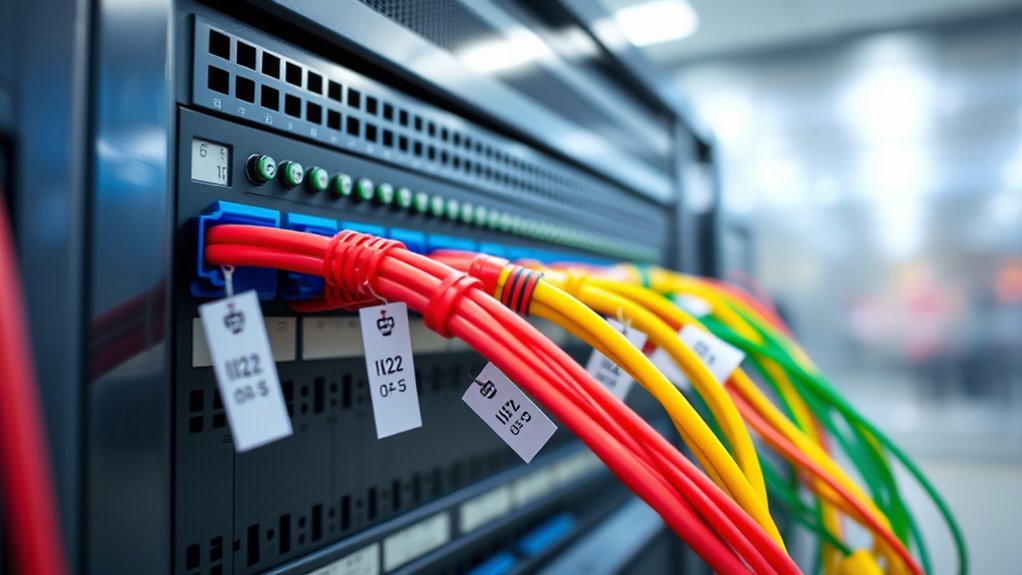
Color coding is a practical method to streamline cable identification and reduce errors during installation and maintenance. Understanding the color code significance helps you quickly recognize cable types and functions. To effectively implement visual identification strategies, consider these steps:
- Assign distinct colors for different systems or functions, like red for power and blue for data.
- Use consistent color schemes across all cables to prevent confusion.
- Combine color coding with labels for added clarity and redundancy.
- Regularly review and update color assignments to reflect system changes.
Maintaining Up-to-Date Records and Labels

Keeping your cable records and labels current is essential for efficient system management. Regularly update labels to reflect changes, using clear and consistent color coding to quickly identify connections. Digital tools can help you maintain accurate records, making updates simple and reducing errors. Use software to log cable details, installation dates, and modifications, ensuring your documentation is always current. When adding new cables or reconfiguring existing ones, immediately revise labels and records to prevent confusion. Consistent labeling practices combined with digital record-keeping streamline troubleshooting and future upgrades. Staying organized minimizes downtime and improves overall system reliability. Regularly reviewing and updating your documentation ensures that everyone involved can quickly access accurate information, saving time and effort in maintenance and troubleshooting.
Implementing Digital Documentation Tools
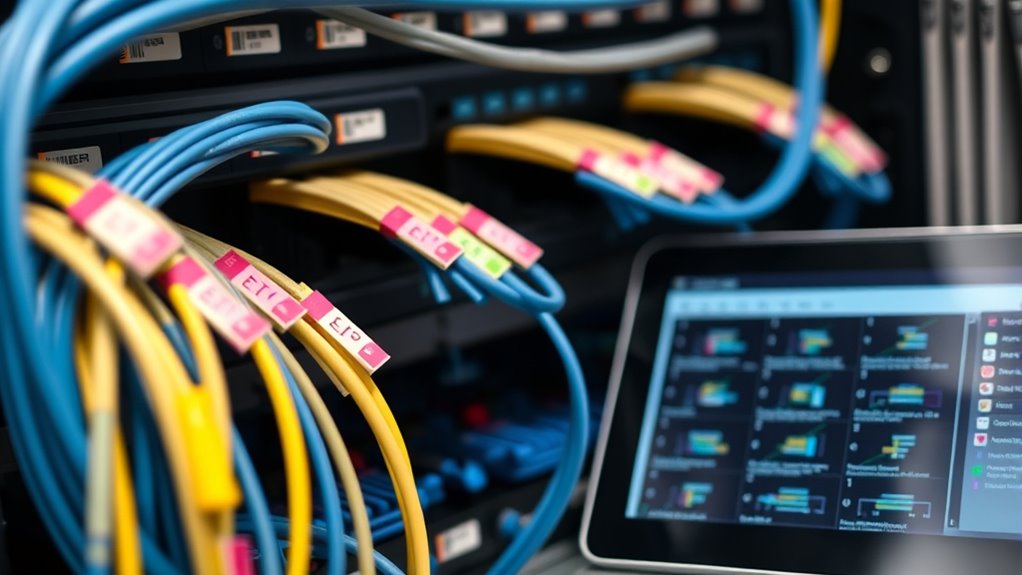
Implementing digital documentation tools can considerably enhance your cable management process by providing a centralized platform for tracking all connection details. Using cloud-based solutions ensures your data is accessible from anywhere, promoting collaboration and reducing errors. To maximize these tools, consider these steps:
- Choose a digital asset management system that suits your needs and integrates with existing infrastructure.
- Store all cable labels, connection diagrams, and maintenance logs within the platform.
- Regularly update documentation to reflect changes, ensuring accuracy over time.
- Train your team on how to access and utilize the system efficiently for quick troubleshooting.
Frequently Asked Questions
How Often Should Cable Labels Be Replaced or Refreshed?
You should refresh cable labels every 1 to 3 years or whenever they show signs of wear, damage, or fading. Proper label maintenance guarantees clarity and longevity, preventing confusion during troubleshooting or upgrades. Regularly inspecting labels helps you catch issues early, maintaining accurate documentation and ensuring labels stay readable. By staying proactive, you extend label longevity and keep your cable management organized and efficient.
What Are Common Mistakes to Avoid When Labeling Cables?
Think of cable labeling as your network’s heartbeat—mistakes can cause chaos. Avoid common pitfalls like neglecting color coding, which can turn clarity into confusion, or choosing labels with poor durability that fade like a sunset. Make certain your labels are robust enough to withstand wear and tear. By paying attention to these details, you keep your cables organized and your system running smoothly, preventing costly errors down the line.
How Can Labeling Systems Accommodate Future Expansions?
To accommodate future expansions, you should implement a scalable labeling system that allows easy updates without redoing everything. Use clear, consistent labels with enough space for additional info, and plan for label longevity by choosing durable materials resistant to environmental factors. Incorporate flexibility into your scalability planning by leaving room for new labels or codes, ensuring your system adapts smoothly as your network grows.
Are There Industry Standards for Cable Labeling and Documentation?
Yes, industry standards for cable labeling and documentation emphasize industry compliance and labeling accuracy. You should follow guidelines like ANSI/TIA-606-B and ISO 14763-2 to guarantee consistency and clarity. These standards help you maintain organized records, improve troubleshooting, and meet regulatory requirements. By adhering to established standards, you ensure your labeling system remains reliable, scalable, and compliant with industry best practices.
What Training Is Recommended for Staff Responsible for Cable Documentation?
Imagine the chaos of unmanaged cables—training your staff in cable management and documentation best practices is essential. You should provide hands-on workshops and certifications focused on industry standards, emphasizing clarity and consistency. By investing in thorough training, your team will master proper labeling, documentation, and maintenance, transforming disorder into seamless organization. This proactive approach ensures reliable system performance and saves time, making your infrastructure robust and resilient.
Conclusion
By embracing excellent organization through thoughtful planning, proper materials, and consistent coding, you’ll create clear, cohesive cable labels and documentation. Stay savvy by updating records regularly and leveraging digital tools for effortless management. With meticulous methods and mindful maintenance, you’ll master your cable system, minimizing mistakes and maximizing efficiency. Remember, successful systematization starts with smart strategies—so stay systematic, stay structured, and stay ahead!
